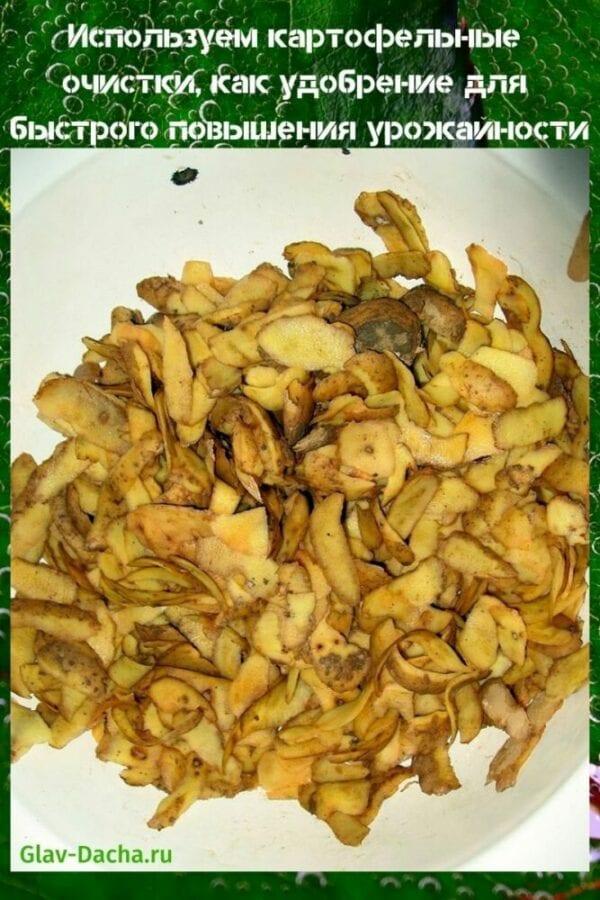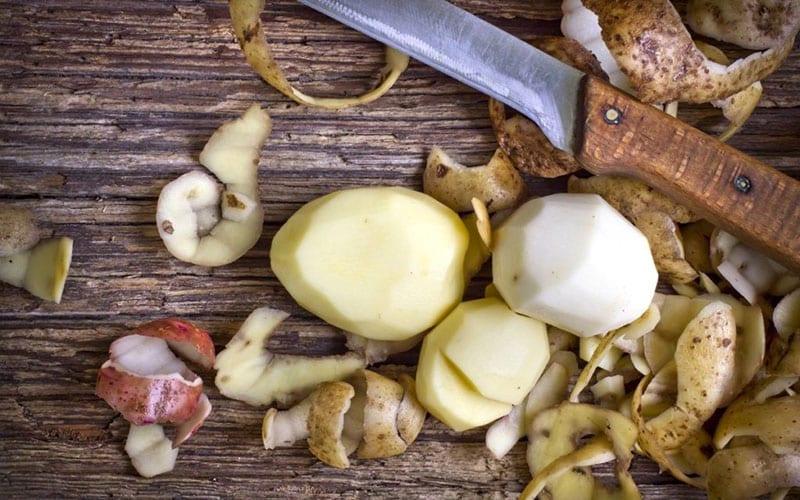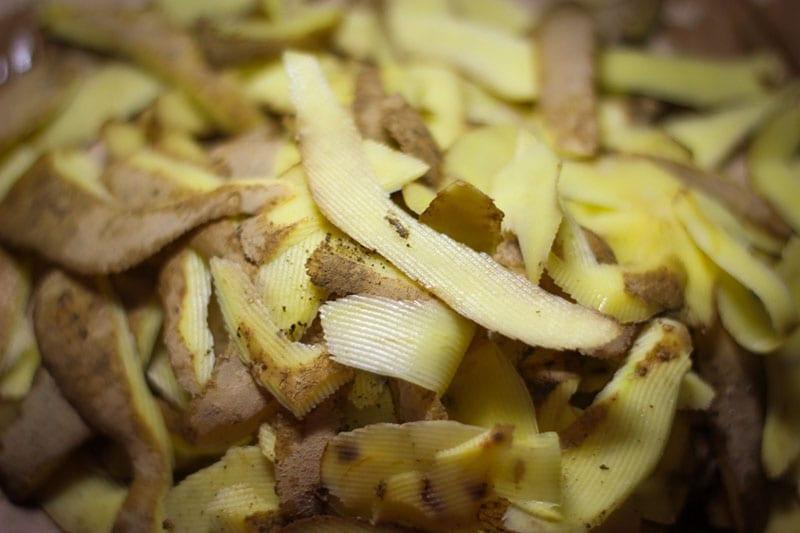We use potato peelings as fertilizer to quickly increase yields
 Potato peels are often used as fertilizer in organic farming. They contain a high concentration of starch, potassium and many other beneficial micro and macro elements. Potato peelings are a natural and environmentally friendly fertilizer that not only nourishes orchard crops with nutrients, but also protects plants from Colorado beetles, slugs and other pests.
Potato peels are often used as fertilizer in organic farming. They contain a high concentration of starch, potassium and many other beneficial micro and macro elements. Potato peelings are a natural and environmentally friendly fertilizer that not only nourishes orchard crops with nutrients, but also protects plants from Colorado beetles, slugs and other pests.
The composition and useful properties of potato peelings

Useful properties of potato peelings:
- starch - saturates the body with energy, stimulating their growth and development, especially starch is important for roses and currants;
- glucose - provides complete protein production and maintenance of vital energy in the winter season;
- organic acids - regulate the course of oxidative processes in plant cells, accelerate the absorption of carbohydrates;
- mineral salts - strengthen the immune defenses of the plant.
 Fertilizer from potatoes is considered an effective organic fertilizing, which is especially important for horticultural plants during the growing season. In the process of decomposition, the waste releases a certain amount of heat, which is necessary for the active development of the plant.
Fertilizer from potatoes is considered an effective organic fertilizing, which is especially important for horticultural plants during the growing season. In the process of decomposition, the waste releases a certain amount of heat, which is necessary for the active development of the plant.
Potato peelings are well processed by bacteria, saturating the soil with beneficial nutrients. This has a positive effect on the fertility and quality of the soil.
What plants are potato peelings used for
 The use of potato peelings as fertilizer is recommended for almost any garden and vegetable garden crops.
The use of potato peelings as fertilizer is recommended for almost any garden and vegetable garden crops.
The most useful feeding for such plants:
- melons and gourds;
- Strawberry;
- raspberries;
- currant;
- eggplant;
- tomatoes;
- bell pepper;
- champignons and other mushrooms;
- houseplants.
 Most of all, this natural fertilizer is "loved" by crops that are not susceptible to diseases affecting potatoes or have strong immunity to them. These include fruit trees and berry bushes.
Most of all, this natural fertilizer is "loved" by crops that are not susceptible to diseases affecting potatoes or have strong immunity to them. These include fruit trees and berry bushes.
Potato peelings as fertilizer - preparation of raw materials
Before using potato peels, you need to properly prepare them. In no case should they be used in their pure form. Rotting processes in fresh raw materials will cause the appearance of pests and rodents, as well as provoke the development of late blight.
Among the most common ways to prepare potato peelings are infusion, freezing, freezing. Also, organic raw materials can be used in the form of crushed flour.
Infusion
 Potato peel for the garden is often used in the form of an infusion. To do this, rinse the fresh rind and transfer to a large saucepan or bucket. The cleanings should occupy about 1/3 of the container, fill them with water. Leave to infuse, then add the soaked peel to the soil.
Potato peel for the garden is often used in the form of an infusion. To do this, rinse the fresh rind and transfer to a large saucepan or bucket. The cleanings should occupy about 1/3 of the container, fill them with water. Leave to infuse, then add the soaked peel to the soil.
A nutritious feed for indoor plants can be prepared in another way - pour fresh potato peel with boiling water and leave for 24 hours.Water indoor and ornamental plants with the prepared infusion.
Freezing
 Potato peelings can be prepared by freezing before use. To do this, cleanly wash and dry the peel, transfer it to a plastic bag and place it in the freezer.
Potato peelings can be prepared by freezing before use. To do this, cleanly wash and dry the peel, transfer it to a plastic bag and place it in the freezer.
Freezing potato peels is great for feeding indoor plants. But the peel must be used immediately after it is thawed, it is impossible to re-freeze the raw material, otherwise it will lose all useful properties.
Drying
 Potato peelings can be dried in a variety of ways - outdoors, in the microwave, or in the oven. In the first case, pour the raw materials in a thin, even layer and leave for 8-10 days in a well-ventilated area.
Potato peelings can be dried in a variety of ways - outdoors, in the microwave, or in the oven. In the first case, pour the raw materials in a thin, even layer and leave for 8-10 days in a well-ventilated area.
It will take only 2-4 hours to dry the peel in the oven at a temperature of no more than 100 ° C. Transfer the dried cleanings to a cotton or paper bag.
Making flour
 As a fertilizer for garden, garden and indoor plants, you can use flour made from potato peel. To do this, the peel must be well dried, and then chopped with a blender, meat grinder or coffee grinder. The flour is slightly diluted with warm water before use.
As a fertilizer for garden, garden and indoor plants, you can use flour made from potato peel. To do this, the peel must be well dried, and then chopped with a blender, meat grinder or coffee grinder. The flour is slightly diluted with warm water before use.
Compost
 With composting, a safe and highly effective fertilizer can be obtained, suitable for all horticultural crops. But this process is very long, it takes at least 12-18 months. Various additives and regular mixing will help speed up fertilizer production compost heap.
With composting, a safe and highly effective fertilizer can be obtained, suitable for all horticultural crops. But this process is very long, it takes at least 12-18 months. Various additives and regular mixing will help speed up fertilizer production compost heap.
In order to obtain fertilizer from potato peelings for currants or other crops, you need to monitor the ratio of carbon and nitrogen substances in the compost heap. With the predominance of nitrogen, decay processes begin, accompanied by a sharp, unpleasant odor. As a result, the feeding will be spoiled. The best option is the ratio of nitrogen to carbon 1: 4.
 If fresh potato skins are put into the compost heap, you will receive nitrogen components. If the cleanings are pre-dried, they become carbonaceous. Add sugar yeast solution to the compost heap to speed up the process. Do not forget to throw the contents of the compost every 3-4 days - this will ensure a uniform flow of oxygen into the heap.
If fresh potato skins are put into the compost heap, you will receive nitrogen components. If the cleanings are pre-dried, they become carbonaceous. Add sugar yeast solution to the compost heap to speed up the process. Do not forget to throw the contents of the compost every 3-4 days - this will ensure a uniform flow of oxygen into the heap.
Technology and feeding scheme
 There are several ways to use potato peelings in your garden. They cannot be simply taken and scattered in the beds, as this will attract pests and rodents. Top dressing is applied according to certain rules.
There are several ways to use potato peelings in your garden. They cannot be simply taken and scattered in the beds, as this will attract pests and rodents. Top dressing is applied according to certain rules.
The best time for potato fertilization is autumn, immediately after harvest. By the onset of spring, it will partially rot, saturating the soil with nutrients.
Top dressing of currants and raspberries
 Potato peels are considered to be one of the best currant fertilizers. They saturate the plant with glucose, starch and other useful elements that have a positive effect on the size and flavor of ripe berries.
Potato peels are considered to be one of the best currant fertilizers. They saturate the plant with glucose, starch and other useful elements that have a positive effect on the size and flavor of ripe berries.
 For feeding currant bushes it is best to use potato peelings in the form of flour, infusion or thick, soaked "gruel". For the best effect, dig in the fertilizer around the stem to a depth of 15-20 cm. This leads to a rapid multiplication of microorganisms that process organic matter and release humus into the soil.
For feeding currant bushes it is best to use potato peelings in the form of flour, infusion or thick, soaked "gruel". For the best effect, dig in the fertilizer around the stem to a depth of 15-20 cm. This leads to a rapid multiplication of microorganisms that process organic matter and release humus into the soil.
Feeding pumpkin and cucumbers
 Potato peels can be an excellent nutritional supplement for pumpkin, cucumber, squash, and squash.
Potato peels can be an excellent nutritional supplement for pumpkin, cucumber, squash, and squash.
How to use organic feeding:
- pour dried potato peel, diluted with warm water on the bottom of the hole;
- sprinkle the fertilizer with a layer of soil;
- add another layer of top dressing and soil;
- plant vegetable seedlings in the hole.
Many summer residents and gardeners recommend using potato peel infusion for watering planted seedlings.This will accelerate the growth of green mass and increase the yield of plants.
For garlic and onions
 from potato peel can be used for growing onions and garlic. For these cultures, a strained infusion of purifications is more suitable. There should be no peel particles in it, as they will attract the attention of insects and rodents.
from potato peel can be used for growing onions and garlic. For these cultures, a strained infusion of purifications is more suitable. There should be no peel particles in it, as they will attract the attention of insects and rodents.
Watering with potato infusion can be started in the second half of May or early June, repeating every 10-15 days. Natural dressing is applied at the root, separately for each bush.
For strawberries
Feeding strawberries with organic fertilizer is carried out according to the following scheme - water each bush with strained infusion or sprinkle with chopped potato flour. Apply the top dressing every 12-15 days.
Potato peelings are a natural and safe fertilizer used in organic farming. Due to its versatility and high efficiency, it is used in the cultivation of both garden and garden, indoor plants. Potato dressing saturates crops with nutrients, ensuring vigorous growth and good fruiting.